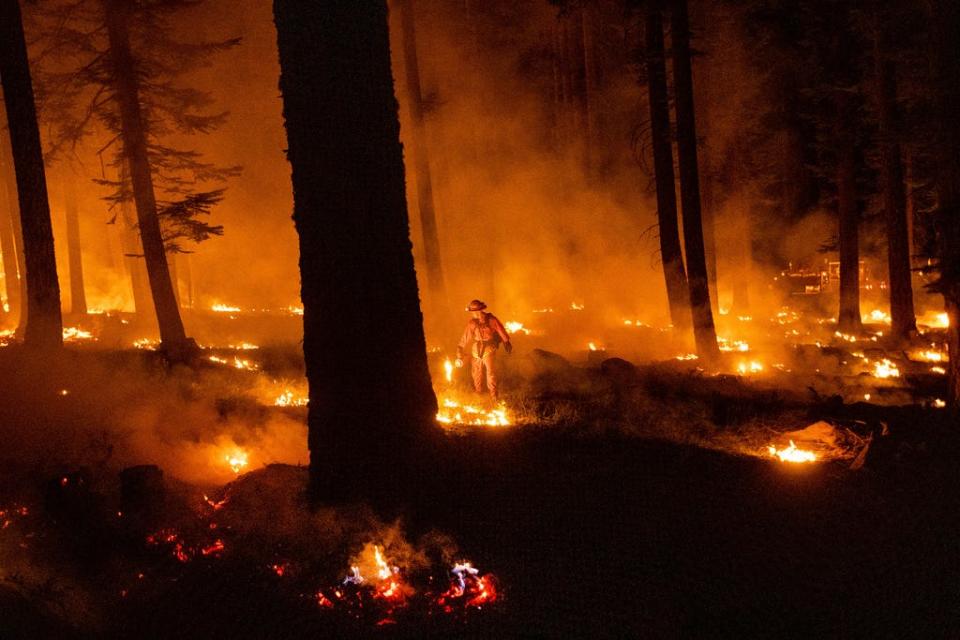Western wildfires: California, Nevada governors tour site of huge blaze; residents urged to conserve energy as conditions worsen
California and Nevada's governors toured near their state line Wednesday to assess damage from a massive wildfire near the border as officials warned residents of the Golden State to conserve energy because of worsening fire conditions.
California Gov. Gavin Newsom and Nevada Gov. Steve Sisolak, both Democrats, called for more federal firefighting assistance in an area near the Tamarack Fire, which has burned more than 68,000 acres between the two states south of Lake Tahoe.
“We need help on the federal side. We need more people coming in. We need more resources. We need more air support. We need more boots on the ground,” Sisolak said.
Newsom said that the U.S. Forest Service, which manages the California region, were understaffed, underfunded and need major changes.
“We have a historic framework that has to be thrown out. You can’t look back a decade or two. The world is radically changing as the climate changes. You may not believe in science, you got it with your own damn eyes,” Newsom said, gesturing toward the blackened landscape.
Firefighters were hopeful for more rain after Tuesday brought cooler, wetter and more humid conditions to fight back the blaze. Thunderstorms and heavy rain were possible Wednesday, the U.S. Forest Service said, and similar conditions could last through Friday.
“This wet stuff fell out of the sky yesterday that I barely remembered and recognized,” Dan Dallas, an incident commander for the fire, said Tuesday.
But much of the rest of the state could see higher temperatures, which prompted California's Independent System Operator, which oversees all power systems in the state, to issue a statewide alert Wednesday asking people to conserve energy later in the afternoon and evening.
The National Weather Service issued an excessive heat warning for areas near the California and Oregon border.
And heat and wildfire danger is expected starting Thursday throughout northwestern Oregon, including Portland, and southwest Washington, weather officials said.
A fire weather watch has been issued because of the potential for “abundant lightning and critically dry fuels (that) may result in numerous fire starts,” the weather agency said. “Thunderstorm outflow winds may result in erratic fire spread.”

More on wildfires: Wind, higher temps could worsen California's largest wildfire; East Coast sees more smoky skies
Though some thunderstorms were possible throughout the West, conditions were expected to remain warm with pyrocumulonimbus clouds, or "fire clouds," possible near dry thunderstorms.
Overall, 81 large wildfires are burning 1.6 million acres in 12 states, according to the National Interagency Fire Center.
The largest remains Oregon's Bootleg Fire, which was sparked by lightning July 6. The fire has burned more than 413,000 acres in the Fremont-Winema National Forest but is more than halfway contained.
Tuesday brought wetter conditions near the fire, and while some storms were possible later in the week, the area was expected to remain dry, with winds growing and humidity dropping, the Forest Service said.
Firefighters said they had contained much of the southern line of the fire but have struggled more with the northwest side because of rugged terrain. "There is a concentration of snags, downed logs and slash that provide heavy fuels to the fire. And while progress is being made, this area continues to be a challenge," Forest Service officials said in a statement.
California's largest fire, the Dixie Fire near Lassen National Forest, has burned more than 220,000 acres and destroyed 31 buildings. It was 23% contained, according to the California Department of Forestry and Fire Protection, but threatened more than 10,000 homes in the region.
Firefighters expected the western part of the blaze to grow in the coming days because of the drier conditions and temperatures "well above normal" Wednesday to Saturday, the Forest Service said.
The fires have also worsened air quality throughout the country. Earlier in the week, the East Coast saw hazy, smoky skies return from fires in the West and Canada. Vermont on Wednesday remained under an air quality alert. Parts of Montana, Wyoming and Idaho had a similar warning.
Scientists agree climate change has made wildfires and their effects in the West worse in recent years as warmer weather and drought fuel the hot, dry conditions.
Heat waves: The heat wave in the West 'virtually impossible' without climate change
In a study published Monday in the peer-reviewed Nature Climate Change journal, researchers found the odds of temperatures breaking record highs by extreme levels – three or more standard deviations – could be seven times more likely in the next 30 years compared with the past 30 years.
Erich Fischer, a researcher at the Swiss Federal Institute of Technology who led the study, told the Guardian the data was "really quite worrying."
“Many places have by far not seen anything close to what’s possible, even in present-day conditions, because only looking at the past record is really dangerous,” he told the newspaper.
In late June, a heat wave in the Pacific Northwest caused hundreds of deaths in Oregon, Washington and British Columbia, Canada.
Oregon Gov. Kate Brown called it "a harbinger of things to come" as it relates to climate change.
Contributing: Doyle Rice and Elinor Aspegren, USA TODAY; The Associated Press
This article originally appeared on USA TODAY: Western wildfires: California and Nevada governors tour site of blaze

 Yahoo Movies
Yahoo Movies 
